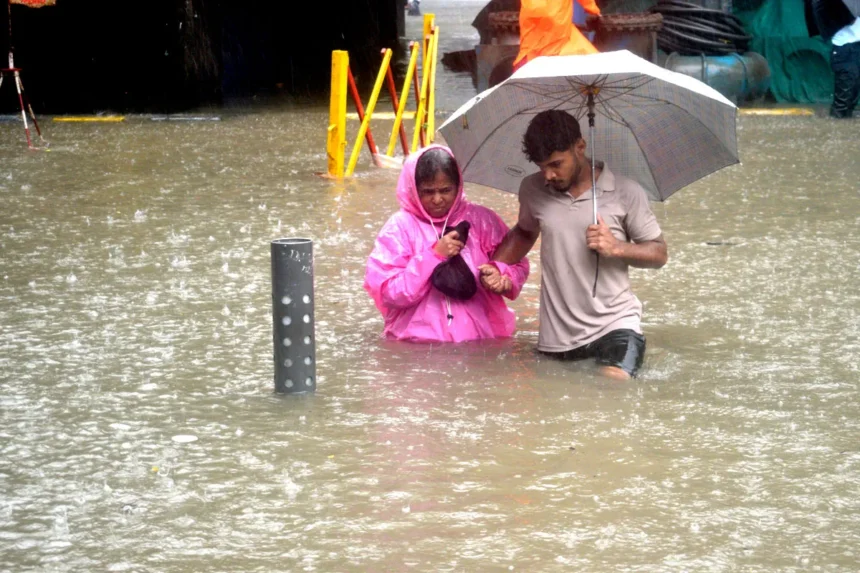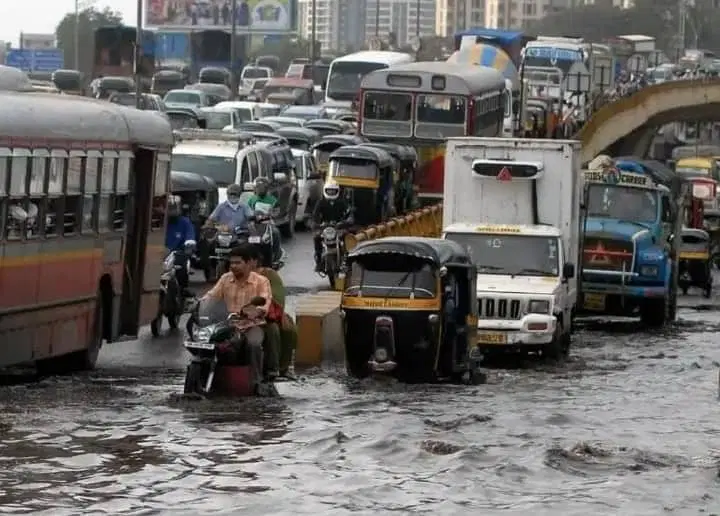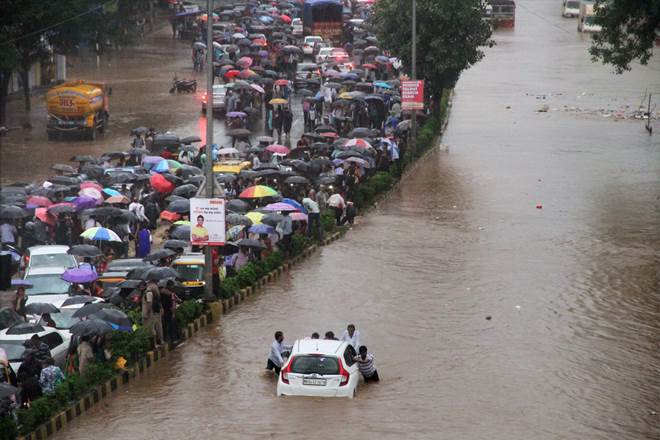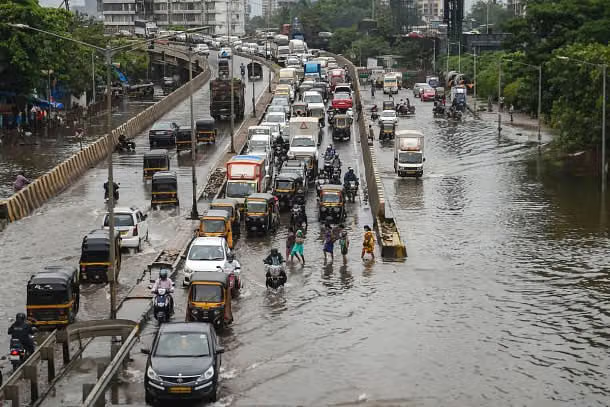MUMBAI – Relentless downpours have overwhelmed Mumbai, leading to floods, swollen rivers, and widespread disruption. The India Meteorological Department (IMD) issued several red and orange alerts, highlighting the severity of the situation.
While the monsoon brings essential water for India’s farms and water supplies, for Mumbai, it has exposed city infrastructure weaknesses and forced a rethink on urban development and climate adaptation.
The southwest monsoon brings most of India’s yearly rain from June to September. It tops up reservoirs and waters fields, giving farmers hope for solid harvests. In rural areas, this season is crucial for crops and food security. In Mumbai, though, these same rains shut down roads and reveal deep faults in public services and ageing systems.
Mumbai’s 2025 monsoon has been unusually fierce. By the middle of August, rainfall had reached 891 mm, far above the city’s August average of 560.8 mm. This marks the wettest August in five years.
Rainfall totals for the monsoon climbed above 2,193.2 mm, passing the long-term average of 2,101.8 mm. Some neighbourhoods, such as Chincholi in Malad, saw 361 mm fall in just 24 hours. Vikhroli, Dadar, Wadala, Sion, Powai, and Chembur logged 200-300 mm, flooding homes and streets.
The IMD released a red alert on 19 August, warning about “intense to very intense” rain, gusty winds up to 60 kmph, and risks across Mumbai, Thane, Palghar, Raigad, and Pune. In response, the Brihanmumbai Municipal Corporation (BMC) closed local schools, colleges, and government offices, and asked businesses to switch to remote work to reduce travel.
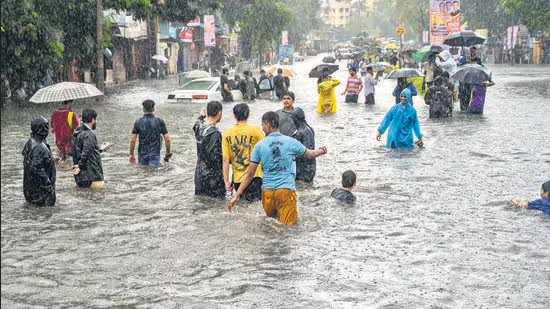
Mithi River on the Brink
A key cause of Mumbai’s floods is the Mithi River, a 17.8 km waterway running through major parts of the city. On 19 August, its water level reached 3.9 metres, almost at the 4-metre danger mark.
Low-lying areas such as Kranti Nagar in Kurla faced evacuations, with over 400 people moved to places like the MM Municipal School, thanks to the National Disaster Response Force (NDRF). The river overflowed as high tides stopped water from draining into the sea, leaving homes and businesses underwater and thousands cut off.
This problem isn’t new. Back in 2005, Mumbai had 944 mm of rain in one day, and the Mithi burst its banks, combining with the worst floods the city remembers and more than 900 casualties. Locals in Kurla, Chunabhatti, Sion, and Chembur still remember that disaster. Despite projects to clear and widen the river, its capacity hasn’t kept up. Reports of mismanaged contracts and corruption in desilting have made many lose faith in BMC’s efforts.
Other rivers added to the crisis. The Ulhas in Thane and Palghar districts also flooded, cutting off areas like Karotiya Nagar and Shahad phata. Waldhuni River, blocked by high tides, spilled over city roads and halted traffic. In Kolhapur, the Panchaganga River crept beyond its alert level of 39 feet, prompting more evacuations.
Life Disrupted as Floods Spread
Constant heavy rain has left major parts of Mumbai underwater, including Gandhi Nagar, Kings Circle, Sion, Dadar, Chembur, and Kurla LBS Road. The city’s massive public transport system, which millions depend on daily, ground to a halt.
Central Railway’s Harbour Line between Kurla and CSMT shut for 15 hours, stranding thousands. Over 135 BEST bus routes abruptly shifted, while 14 flights had to turn back or circle due to thick clouds and poor visibility.
The toll is heavy. A man suffered electrocution on Bhandup’s LBS Marg. Two more deaths were reported in Napean Sea Road and Kanjurmarg. In the Nanded district, sudden heavy rain led to eight deaths and left five missing. Across Maharashtra, six died in the last day due to floods, and huge swathes of farmland, up to 14 lakh hectares, were ruined, hitting farmers hard.
Online, images of the floods, stranded commuters, and even a python gliding through Navi Mumbai’s submerged streets have shocked viewers. The sight of the flooded new Worli Metro Station, a flagship project, sparked public anger and fresh criticism of the city’s drainage and planning.
Why Do the Floods Keep Coming?
Experts say Mumbai’s flood troubles can be traced to climate change, haphazard building, and outdated infrastructure. The IMD noted that city rainfall now falls in shorter, heavier bursts. This year’s monsoon arrived earlier than usual, with 295 mm falling in May, the highest for that month since 1918.
Warmer seas have increased storm activity and heavier monsoon currents, adding to the risk. Mahesh Palawat of Skymet pointed to a depression in the Arabian Sea, which pulled in the rains and made them worse.
Mumbai’s position—coastal and low-lying—already makes it prone to flooding, but recent development has pushed the problem further. Clearing mangroves and building on natural floodplains has blocked natural drains. The BMC’s storm drains, made for low tides, can’t cope when the sea is high and floodgates close. Despite 525 pumping stations working round the clock, the sheer amount of water often wins.
Local government responses have been criticized. Desilting work sometimes remains unfinished or poorly done, and debris from Metro construction clogs drains. Residents who lost homes in earlier floods say they live in fear, with rainwater already rising to their doorsteps this year.
Can Mumbai Move Past the Floods?
Mumbai is slowly restarting, with trains running again and schools reopening from 20 August. The Chief Minister, Eknath Shinde, and Deputy Chief Minister, Ajit Pawar, have been on the scene, while NDRF and SDRF teams carry out rescues across the state. In Nanded, 293 people were rescued from flooded areas, and 350 were pushed to safety in Kurla. Yet, the damage to lives and property is significant.
Officials are now considering solutions like holding ponds to catch rainwater, with the Andheri subway pinned as an example. Lasting change, though, needs bigger reforms—updating drainage, saving what remains of the city’s natural defences, and ensuring construction rules are followed. Better flood protection must match the needs of a growing population.
With more rain expected through 21 August, Mumbai’s people brace for further challenges. The community remains strong, but year after year, heavy monsoon rain threatens to bring life to a standstill and puts Mumbai’s place as an economic leader at risk if concrete steps aren’t taken soon.




